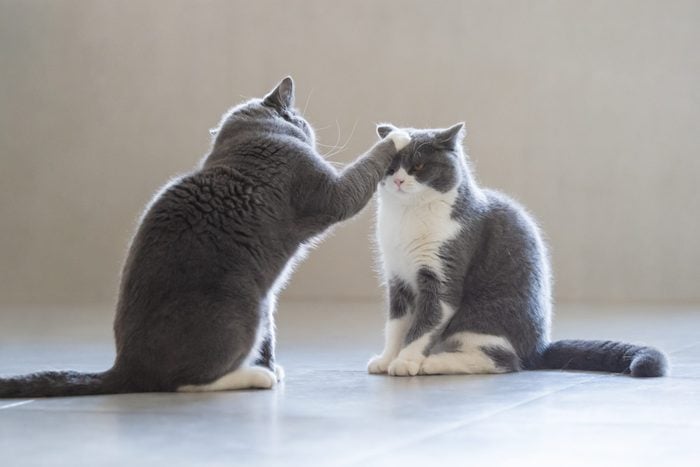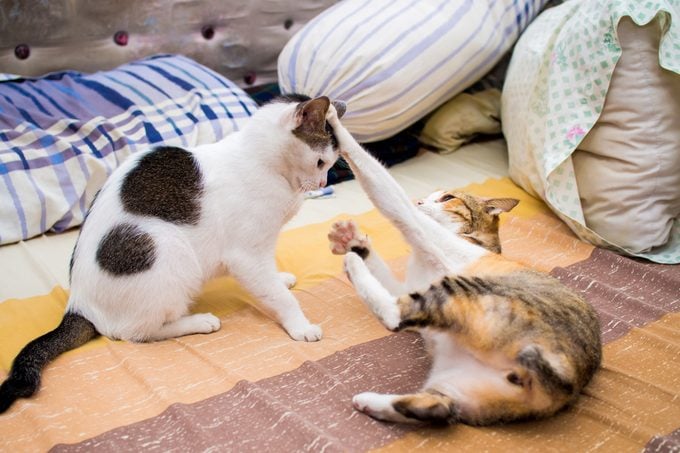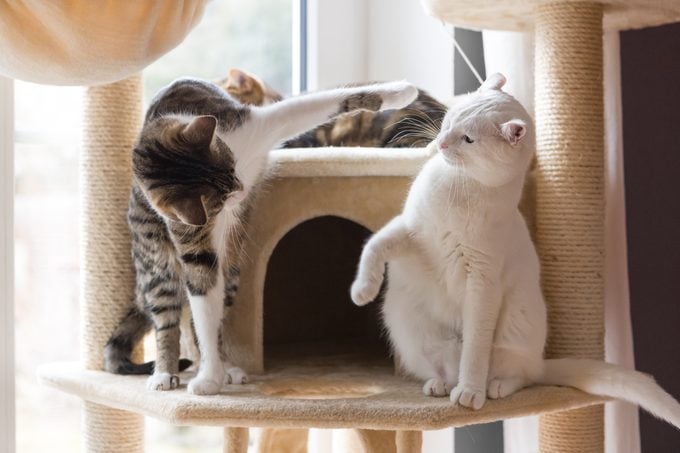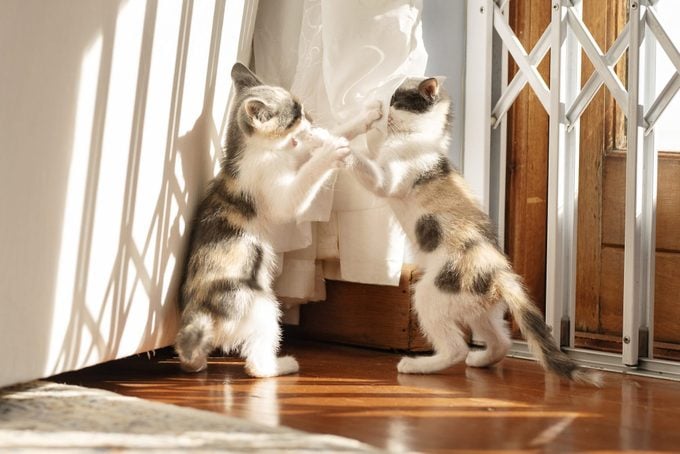How to Stop Your Cat from Bullying Another Cat
Updated: Apr. 24, 2024

Does your sweet kitty turn into an overbearing jerk when his feline sibling enters the room? Here's how to stop your cat from bullying another cat and calm the conflict in your feline family.
Veterinarians see it all the time: A cat owner loves their cat—so much, in fact, that they decide to go out and adopt another cat to keep the first one company. And that’s when the fur starts flying. “Sometimes you get lucky, and they end up loving each other and becoming best friends right away,” says Ashlie Saffire, DVM, a veterinarian in Dublin, Ohio. “And sometimes they definitely do not.” It’s the latter case that may have you tearing out your hair and googling “how to stop my cat from bullying my other cat.”
While some cats will happily welcome a new feline roommate into the fold, others view the arrival of a second cat as nothing short of an invasion. Suddenly there are hisses, growls and surprise attacks on the way to the litter box. What causes an otherwise sweet-natured kitty to suddenly become angry and stalk, attack and torment its new roomie? And how do you stop your cat from bullying your other cat?
Experts say that answering those questions requires a close look at the dynamics of your kitty family. “A bully cat’s aggression is born out of fear,” says Dr. Saffire. “He’s trying to protect his territory. And the cat that’s being bullied is also afraid. They’re hissing and screaming and making all the sounds because they’re scared and they’re trying to act big and scary to protect themselves.”
Fortunately, there are tricks to help stop a cat from bullying. By learning to understand cat behavior and read a cat’s body language, you can train your cats to get along and restore peace to your feline family. “You can’t force cats to be best friends,” says Dr. Saffire, “but you can help them to live together peacefully.”
Get Reader’s Digest’s Read Up newsletter for more pets, humor, cleaning, travel, tech and fun facts all week long.
Why does a cat bully another cat?

There can be any number of reasons for friction between cats, but they usually center around one cat feeling like it’s in danger of losing the things it considers its most valuable assets: its food, water, litter box, sleeping space or even its humans. “What people label as bullying is really a cat feeling threatened,” says certified cat behaviorist Pam Johnson-Bennett.
It’s protecting its resources
Cats are sociable animals but only if they feel there are enough resources for everyone. And to a cat, resources means easy access to food, water and the litter box.
“That’s the No. 1 issue I see in multi-cat households where they call me about having a bully cat or cats who fight,” says Johnson-Bennett. “If a cat’s path to the litter box is blocked by another cat, or the only way for a cat to get to the food or water bowl is to cross enemy lines, that creates a lot of stress, and that’s where you end up with fighting.”
It’s defending its space
Cats have sleeping areas and lounging areas that they think of as theirs, sometimes including their humans’ laps. And when they see another cat in what they consider their spots, they view it as an incursion.
“Cats are territorial,” says Dr. Saffire. “It’s in their DNA. In the wild, cats will claim huge amounts of territory. So what happens when we bring them inside and force them to live together in a very small space? It can be a trigger for bullying.”
Their personalities clash
Just like people, cats have different personalities, and one cat may be naturally more dominant than the other. “If you have one cat who’s very outgoing and one cat who’s quiet and anxious, that’s going to [be] a factor,” says Dr. Saffire.
Cats that weren’t raised together may also have different social skills. “One cat may be doing a play posture but the other cat is misreading it and feeling threatened,” says Johnson-Bennett. “And there are some cats, just like people, that are clearly more comfortable not having roommates.”
They were never properly introduced
When you bring a new cat into a home where there is already a cat or multiple cats, how you introduce them sets the stage for their future behavior. “The biggest mistake I see is rushing that introduction and expecting the cats to just work it out,” says Johnson-Bennett. “You have to take baby steps and do it gradually, helping everyone feel comfortable and safe. Rushing that introduction puts everyone into survival mode, and everyone feels threatened.”
Signs a cat is bullying another cat

Before you learn how to stop a cat from bullying another cat, you need to figure out whether bullying is actually happening. It’s not as obvious as you may think.
Sometimes cats will get into all-out brawls, but often, the signs that one cat is bullying another are less conspicuous. “You may not see actual fighting,” says Johnson-Bennett. “It could be a lot of posturing and guarding of resources. There are a lot of subtle things you can see as you watch your cat.”
Aggressive body language
It’s actually quite easy to spot an angry cat if you pay attention to the cat’s body language. “When cats are happy, their whiskers are relaxed, their ears are forward, their eyes are relaxed,” says Dr. Saffire. “But when a cat is feeling fearful or aggressive, their ears will flatten, their whiskers get really straight and their pupils become dilated. Those are signs that there’s an issue.”
One-sided play
“When cats play, sometimes it can look like they’re fighting, but it should be mutual, where they take turns doing the chasing,” says Johnson-Bennett. “If you see one cat is repeatedly the one getting chased and there’s hissing or the body posture seems as if it’s not friendly, that’s not play. Then you have a situation where one cat is feeling threatened by the other cat.”
Guarding behavior
What may look like a cat casually lounging outside the door to the room with the litter box may actually be him positioning himself there to keep other cats out. “Cats can interpret that body language better and see that there’s a guarding behavior,” says Johnson-Bennett. “It’s not a relaxed posture. It’s more of a dare or a threat.”
That’s especially true if the lounging cat is trying to stare down the other. “Direct eye contact is one of the most intimidating things a cat does,” says Dr. Saffire. “When a cat locks eyes with the other cat, that is a sign this cat is blocking or trying to claim his territory.”
Hiding
“A cat who feels threatened or who has been attacked may hide a lot,” says Johnson-Bennett. “They know there’s a threat, and they don’t want to be visible. They may tend to walk more on the perimeter of the room because they don’t feel comfortable walking right down the middle.”
Stress behaviors
Cats that feel threatened often become anxious and engage in behaviors tied to stress, like scratching the furniture, peeing on the carpet or over-grooming. “They may groom themselves so much they create a bald patch,” says Johnson-Bennett.
How to stop your cat from bullying another cat

You’ve seen the signs, and it’s pretty clear you have a feline bully on your hands. You’ve no doubt taken to the internet with the query “how to stop my cat from bullying my other cat.” And right about now, you’re probably at your wit’s end. Don’t worry—the experts are here to help.
As with other undesirable cat behaviors, the key to solving the problem is figuring out what’s triggering it. “Is it that there aren’t enough resources? Is it that I didn’t introduce them properly? Is it that one cat is misreading another cat? The key to solving a behavior problem, whatever it is, is to identify the cause,” says Johnson-Bennett.
Step 1: Rule out any medical issues
Sometimes cats can lash out because they’re uncomfortable, so it’s wise to make sure a medical issue isn’t causing your cat’s aggression. “I always tell clients to go to the vet first,” says Johnson-Bennett. “Many times, they’ll email back and say, ‘Oh my gosh! You were right. He was attacking because he was in pain.'”
Step 2: Assess your situation
To figure out what the cats’ issues are, it can be helpful to draw a floor plan of your home, marking out where your cats’ food, water, litter boxes and favorite lounging areas are, as well as the spots where their skirmishes usually occur. The trouble zones are likely related to one cat crossing into what another considers its territory. “A lot of times, we can then figure out where the friction is coming from,” says Dr. Saffire.
Step 3: Spread out their resources
Place food and water bowls in different areas of your home. “It’s not just about having multiple food bowls; it’s where you place them,” says Dr. Saffire. “If all the bowls are in the kitchen, you’re forcing the cats to eat together or for one to cross into the other’s space in order to get food. But if you separate the food sources around the house, there’s no reason to fight.”
The same goes for litter boxes: Put them in different rooms, so if one cat is blocking access to one box, the second cat has an option.
Step 4: Increase their territory
You can’t make your home bigger, but you can add vertical space inside it. “The best way you can increase the vertical space in your home is with cat trees—and more than one of them because if you just have one cat tree and you have two cats, only one of them gets to go to the top of it,” says Dr. Saffire. “There are also really cool shelves that look like normal shelves but are built for cats, so a cat can climb up on it and be up high.”
Step 5: Give them some alone time
“Maybe at night you separate the cats and leave them in different parts of the house to give the anxious cat some time where he doesn’t have to worry that someone is going to pounce on him or he’s not going to have access to food,” says Dr. Saffire. “It doesn’t have to be a forever thing. It’s just a way of getting the cats more comfortable and reducing the stress level in the house.”
And if it’s a person the cat is territorial over, try separating the cats and then spending some one-on-one time with each of them. “Sometimes that means I’m going to put Cat A away for an hour, and I’m going to sit on the couch and play and pet or groom Cat B,” says Dr. Saffire. “Just spend one-on-one time with each cat so they’re getting that predictable human interaction that they want. They see ‘OK, he’s not a threat because my owner loves me and is going to spend time with me too.'”
Step 6: Head off problems before they happen
If trouble does start to brew, the best solution is to stop it before it becomes a full-fledged fight. “If you can catch it before it escalates, distracting both of them is the biggest thing,” says Dr. Saffire. “Food, treats, a toy—whatever. Just try to distract them both so they’re not fixated on each other. But you still have to figure out what was the reason they were about to go at it so you can prevent it in the future.”
And while you do, it might be a good idea to give the attacking cat a collar with a bell on it. “That way, when he comes into the room, he’s jing-jingling his little collar so the other cat has a warning to be able to get up and get away,” says Dr. Saffire. “So there’s no surprise attacks!”
Step 7: Reinforce good behavior
When the cats are getting along, praise them for it. “I say anytime the cat is doing a behavior that you want them to do—they’re both in the same room together not killing each other—that’s when you give them all the positive reinforcement, the praise, the treats,” says Dr. Saffire. “Any time the cat comes in the room and he doesn’t care that the other cat is sitting in there, that’s when you praise them. Cats are so responsive to positive reinforcement. That’s the best way to really solidify that that’s the behavior you want.”
Step 8: Create a calming environment
For some warring cats, a pheromone diffuser like the one from Feliway, made specifically for multi-cat homes, can help keep the peace. It releases a synthetic pheromone that helps the cats think they are part of the same litter, says Dr. Saffire.
“Put it in the room where they spend the most time,” she says. “You want them basking in it, so when they do come across each other, they smell this pheromone and think, ‘Oh, you’re my littermate. I’m supposed to like you.'”
She also recommends over-the-counter calming treats from Composure to help stop a cat from bullying. “It’s not a drug, but it has things like tryptophan and milk casein protein, which we know are naturally calming,” she says. “They’re safe for pretty much any cat, and it can help just chill everybody out.”
How not to handle cat bullying

While it can be stressful for cat parents to see their cats fighting, there are definitely some things you should not do when it happens.
Don’t punish the cat
“No yelling, no hitting, no squirting with water bottles,” says Johnson-Bennett. “All that does is make the cats hate each other more. The cat who was being terrorized doesn’t know who you’re yelling at, so now they’re even more afraid. And the cat that was displaying the aggression now has no reason to ever like the other cat because now they have a negative association with his presence.”
Don’t jump into the fray
If you put your hands between fighting cats, you’re likely to get injured yourself. Instead, you can break it up by throwing a blanket on one of the cats. “It completely distracts them,” says Dr. Saffire. “You’ll have time to pick up one of the cats or shoo him out of the room, but you’re not touching them and potentially going to get bit.”
Don’t ignore it
If they haven’t already worked it out on their own, the cats likely won’t be able to, and the stress of dealing with it could cause health issues in both the bully cat and its victim. “Don’t just live with it,” says Johnson-Bennett. “Don’t resign yourself to the fact that the cats will never get along, because it’s very stressful for them. No one wants to live under stress, and it can affect them medically.”
What to do if the cat bullying won’t stop
If you can’t figure out the cause for the bullying or how to stop one cat from bullying the other cat, or if either cat is getting injured, it’s likely time to call in a pro. “That’s where people like me come in,” says Johnson-Bennett. “Sometimes, someone who is looking at it from a non-emotional standpoint can pick out where the shortcomings are.”
In some cases, vets will also prescribe medication to help calm cats suffering from anxiety. But if you’ve tried everything—from googling “how to stop my cat from bullying my other cat” to giving your furry friend calming treats, de-stressing cat toys and medication—and the cats still can’t coexist peacefully, it may mean that you will need to set up one of the cats in its own living space. “Again, that’s where an expert can help you,” adds Johnson-Bennett. “If all other options have been exhausted, sometimes the least stressful thing to do is to keep the cats separate.”
Fortunately, it doesn’t usually come to that. Most cats, when all their needs are met and they’ve had time to get to know each other, can coexist quite happily together. “The most important thing is everyone should feel safe in the home,” says Johnson-Bennett. “They don’t have to be best friends, but they have to be safe.”
About the experts
- Ashlie Saffire, DVM, DABVP, is a veterinarian with Faithful Friends Veterinary Clinic in Dublin, Ohio, and a member of the board of directors for the American Association of Feline Practitioners.
- Pam Johnson-Bennett is a certified cat behaviorist, author of Cat vs. Cat and owner of the private veterinarian–referred behavior company Cat Behavior Associates in Nashville.



